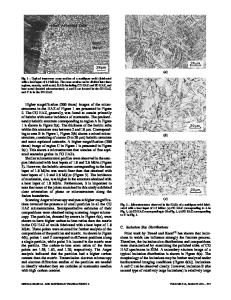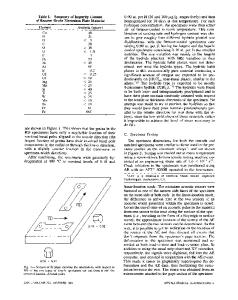Dynamic fracture initiation behavior of an HY-100 steel
- PDF / 3,869,512 Bytes
- 12 Pages / 597.28 x 785 pts Page_size
- 30 Downloads / 310 Views
.
INTRODUCTION
IN some metals, depending on the prevailing mechanical and microstructural conditions, fracture may undergo a transition from a brittle to a ductile mode as the c r a c k advances in quasi-static and dynamic loading conditions, tI.2] The reason f o r this transition is an important scientific issue in materials science because it involves both the microstructure o f the material and the mechanical stress and deformation fields that develop for a given microstructure. An interesting example occurs in the fracture behavior o f an HY-100 steel over a range of temperatures in which fracture initiation occurs either by quasi-cleavage or through a ductile fracture m o d e . Since HY steels are used in the construction o f p o w e r plants and naval vessels, they must be tough enough to withstand without failure the massive structural deformation possible under impact loading. Thus, the HY-100 steel, which has a minimum yield strength o f 690 M P a (100 ksi), has to possess the combination o f high strength and toughness for service conditions that involve dynamic loading. These properties must be coupled with a high resistance to c r a c k initiation and propagation such as may be encountered at relatively low temperatures. Dynamic fracture experiments on HY steels have been o f increasing interest and pursued by many investigators, t3-61 although at somewhat l o w e r loading rates. The purpose o f the present study is to characterize fracture toughness under both dynamic and quasi-static loading over a wide range o f temperatures and to investigate the SUNGHAK LEE, Associate Professor, Department of Materials Science and Engineering, Pohang Institute of Science and Technology, and K. CHO, Assistant Professor, Department of Metallurgical Engineering, Pusan National University, Pusan 609-735, Korea, have been jointly appointed with the Center for Advanced Aerospace Materials, Research Institute of Science and Technology, Pohang 7906 0 0 , Korea. JE WON RHYU, Research Assistant, is with the Department of Materials Science and Engineering, Pohang Institute of Science and Technology. J. DUFFY, Research Professor, is with the Division of Engineering, Brown University, Providence, RI 02912. Manuscript submitted January 1 7 , 1992. METALLURGICAL TRANSACTIONS A
effects o f microstructure on the fracture toughness o f an HY-100 steel. The experimental technique used in the present study for the measurement o f fracture toughness at high loading rates is based on the principle of Kolsky's split-Hopkinson bar. t7] A sharp-fronted tensile pulse is initiated explosively at one end o f a long cylindrical bar o f the specimen material. This pulse propagates down the bar to a circumferential precracked fatigue notch, where fracture occurs. A stress intensity rate o f approximately 2 × 106 M P a V ~ / s is achieved by this method. For comparison purposes, fracture toughness in the quasistatic loading condition was also measured at a rate o f about 1 M P a V m / s . Toughness-microstructure correlations can be developed b
Data Loading...











